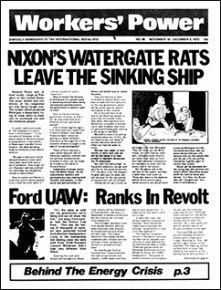A socialist paper in the 1970s
introduced a new section of the Marxists Internet Archive featuring Workers' Power, the paper of the International Socialists published between 1970 and 1978.
ON SEPTEMBER 17, 1964, the Berkeley Independent Socialist Club (ISC) was founded by a small group of "Third Camp" revolutionary socialists, led by Hal Draper and myself. The Club originated following a years-long faction fight in the Young People's Socialist League and the Socialist Party to defend the political program of the Workers Party/Independent League (WP/ISL), against former comrades, Max Shachtman and his supporters, who were swinging rapidly to support of the Democratic Party and American imperialism.
Like the WP/ISL, the ISC was defined by its uncompromising opposition to imperialism of any kind, summed up in its programmatic slogan, "Neither Washington nor Moscow, but for the Third Camp of International Socialism."
Among the ISC's distinctive contributions to left-wing politics in the 1960s was Hal Draper's concept of "socialism from below"--a reaffirmation of Marx's core vision of socialism as mass revolutionary, democratic, working-class revolt, controlled from below. Draper's model rejected both the prevailing schemes of "socialism from above" presented by social democratic parliamentary reform on the one hand, and Stalinist nationalization of industry on the other.
The theoretical bedrock of ISC politics was the self-emancipation of the working class--the idea that socialism's essence is workers' power, working class rule over society through workers' control of the economy and the state through organs of direct workers' democracy.
From 1964-69, the ISC was primarily a student organization, playing an active role in the Black liberation, Free Speech and anti-Vietnam War movements. It supported women's and gay liberation even before those movements arose in the '60s. The ISC was also involved in the farmworkers' unionization effort, in teachers unions, and played a leading role in organizing the first campus clerical workers union.
Some of the key political ideas the ISC fought for on the left--independent political action, Black Power and armed self-defense--began to take tangible form in 1967. The ISC was the driving force in the organization of the Peace and Freedom Party (PFP), and in the creation of the alliance between the PFP and the Black Panther Party around the Free Huey campaign and the running of Huey Newton (from jail) for Congress and Eldridge Cleaver for president.
From 1965-67, local clubs with similar politics came into existence in New York, Baltimore and a few other cities. In 1967, they joined together in a loose federation, the Independent Socialist Clubs of America (ISCA) and began publication of the Independent Socialist magazine, first from New York, then from Berkeley.
After the Students for a Democratic Society splintered in 1969, a small section of SDS fragments joined with ISCA on Labor Day 1969 to form a national organization, the International Socialists. At the same time, the IS newspaper was renamed International Socialist.
IN SEPTEMBER 1970, the IS organizational center was relocated to Detroit; the newspaper was renamed Workers' Power and became a bi-weekly. In October 1975, it moved to weekly publication. The name Workers' Power symbolized both the fundamental political program of the IS and the IS's new strategic orientation.
Out of the international working-class upheavals following 1968, there arose for the first time since the late 1940s the possibility of building revolutionary workers' parties to the left of the social democratic and Communist Parties. The perspective of the IS, based on the experience of its predecessors--the Communists of the 1920s, the Trotskyists of the 1930s and the Workers Party of the 1940s--was that the road to a revolutionary workers party in the U.S. was through a rank-and-file movement in the trade unions based on a clear class struggle program.
To maximize the strength of its small forces, the IS prioritized its industrial work around auto, steel, Teamsters, telephone, the postal service and teachers. Its newspaper, written for factory sales, concentrated on rank-and-file and social movement struggles. Workers' Power carried extensive coverage of the historic working-class revolt of this period, which was and has been generally ignored by most publications and historians.
Its reporting of the auto industry and the United National Caucus, of telephone and the United Action caucus, of the Teamsters and Teamster for a Democratic Union, Upsurge and the Teamster strikes of 1975-76, and of Steelworkers Fight Back and the Ed Sadlowski campaign, are of such depth that students of the period will find more coverage in Workers' Power than possibly anywhere else.
Workers' Power was also a prime source for coverage of the anti-racist struggle, the women's and gay liberation movements and other fights against oppression, as well as prison revolts. Its foreign coverage spanned the Middle East, Africa and Latin America, as well as the European revolutionary left. It also features unique, detailed coverage of the Portuguese Revolution.
The youth group of the IS, the Red Tide, an overwhelmingly working-class and Black organization, provided in-depth coverage of youth and high school struggles.
From 1968-72, and again from 1973-74, the editor was Kit Lyons; from 1972-73, David Finkel; from 1974-76, Gay Semel; in 1977, Kim Moody; and in 1978, Marilyn Denton. The paper was distinctive in the left of that period for the outstanding quality of its art and cartoons, the work of Lisa Lyons.
Click here to go to the Marxists Internet Archive to read issues of Workers' Power.



